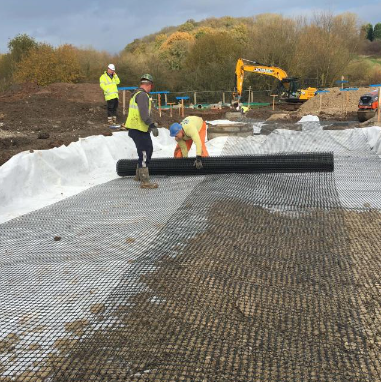- Understanding the Role of Geomembrane Liners in Waste Management
- Innovations in Geomembrane Liners for Water Management
- Geomembrane Liners: A Comprehensive Guide
- The Future of Geomembrane Liners in Civil Engineering
- Geomembrane Liners: Enhancing Landfill Stability
Manager:
WhatsApp:+86 177 0135 2670
Tel:+86 177 0135 2670
Email:marketing@okorder.com
Address:3rd Floor, No.2 Building, No.1 Sanlihe Road
Is geogrid directional?
In modern civil engineering, geogrids are very crucial for the reinforcement and stabilization of soil structures. Over time, different kinds of geogrids have been developed as technology in construction advances with each having its own unique properties and applications. These include plastic geogrids, wholesale geogrids, fiberglass geogrids and glassfiber georids. It is common to ask whether these materials are directional. This article delves into the properties of geogrid to ascertain if they are really directional.

Understanding Plastic Geogrids
A popular material used in civil engineering for high tensile strength and durability is plastic geogrids which can be made from either high density polyethylene (HDPE) or polyproppylene(PP). Normally, they are extruded then oriented so that the polymer chains get aligned for improved mechanical characteristics.
One may wonder if plastic geogrid exhibits any directionally behavior. The answer lies in how they are produced. The process of manufacturing involves orientating the polymer chains in a definite direction usually machine direction (MD) or transverse direction (TD). Thus it becomes anisotropic property because its mechanical behavior changes with direction.
When engineers employ plastics geo-grids for designing reinforcement works, they must consider their orientation characteristics. In some instances such as retaining walls among others like embankments and road construction activities proper orientation ensures that performance is optimized hence stability is attained.
Exploring Wholesale Geogrids
Wholesale Geogrids represent a wide range of bulk-distributed geosynthetic products used during various construction projects. For example, there exist distinct material variations such as plastic fiberglass and glass fiber.
Wholesale Geogrid’s directional behavior is similar to their constituent materials. Plastic-based wholesale Geosynthetics inherit directional characteristics like those possessed by plastic grids whereas fiberglass and glassfiber wholesale grinds do the same with their respective materials.
Therefore, engineers and contractors who buy wholesale geogrids should take into account the orientation properties of these products to install them correctly. Thus, this scrutiny makes geogrid reinforcement systems more effective as well as enhance overall stability and improve longevity of civil engineering projects.
The Role of Fiberglass Geogrids
Fiberglass geogrids are made up of high-strength glass fibers coated with a polymer resin, which affords excellent tensile strength and dimensional stability. In view of this, these geogrids have resistance to environmental factors such as moisture, chemicals and biological degradation making them suitable for long-term purposes.
In terms of directionality, imbued in fiberglass grinds is an isotropic characteristic whereby it exhibits the same mechanical behavior regardless of its direction. For instance unlike plastic geo-grids which have an inherent directional orientation; fiberglass grinds on the other hand distribute their carrying load homogeneously irrespective of where force is applied upon them.
Designing and installing fiberglass geogrids is simplified by their isotropy since there are no special alignment or orientation requirements that need to be considered by engineers. The construction industry has found an ally in contractors who can rely on the versatility and ease associated with using fiberglass grids thus efficient construction practices with reliable performance have been possible.
Unraveling glassfiber geogrids
Like their fiberglass counterparts, glassfiber geogrids are made from glass fibers that are embedded in polymer matrices. These geosynthetics exhibit high tensile strength while being resistant to environmental degradation hence are useful in several types of soil related applications.
As far as directionality is concerned glasfiber grinds behave similar to fiberglass ones because their performance remains consistent irrespective of forces acting against them. This enables engineers to use glass fiber grids without specifying any particular orientation considerations.

Conclusion
In conclusion, glassfiber geogrids are versatile and usable in various civil engineering projects including road construction, slope stabilization and reinforced soil structures because they are isotropic. These geogrids have the ability to be installed easily as well as perform reliably hence making them beneficial to contractors leading to success in construction efforts.
Understanding the directional behavior of geogrid is crucial for engineers that engage in civil engineering aspects such as contractors. Thus, it is important for them to ensure they are properly aligned and oriented with respect to their reinforcement and stability towards the soil structures, which eventually lead into durability and safety of infrastructure projects. Directional considerations significantly influence the success and sustainability of constructions whether plastic or fiberglass or glassfiber geogrids are used.”
- Previous:Why geotextile is used?
- Next:What can I use instead of geogrid?
-
2024-06-12Asphalt fiberglass geogrid construction plan
-
2024-06-04Asphalt fiberglass geogrid construction plan
-
2024-05-21What is the disadvantage of geogrid?
-
2024-05-21What is the lifespan of geogrid?
-
2024-05-21What are the 3 main uses of a geotextile?






